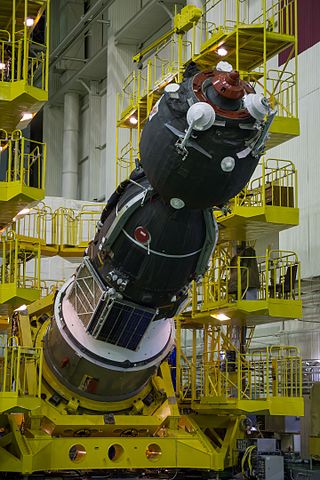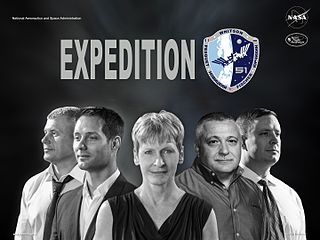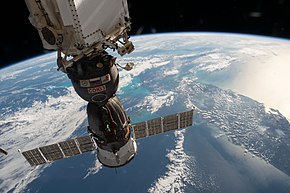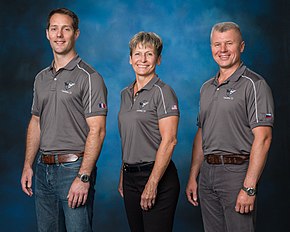
Peggy Annette Whitson is an American biochemistry researcher, retired NASA astronaut, former NASA Chief Astronaut, and an active Axiom Space astronaut. Whitson has a total of 675 days in space, more than any other American or woman.

Fyodor Nikolayevich Yurchikhin is a Russian cosmonaut of Greek descent, engineer and RSC Energia test-pilot who has flown on five spaceflights. His first spaceflight was a 10-day Space Shuttle mission STS-112. His second was a long-duration stay aboard the International Space Station (ISS) as a flight engineer for Expedition 15; for this mission he was launched in the Soyuz TMA-10 spacecraft. He has undertaken two further long-duration stays aboard the ISS, as a crew member of Expedition 24 / 25. For this mission he was launched with the spacecraft Soyuz TMA-19, and he landed in November 2010, also with the Soyuz TMA-19 spacecraft. He served as Soyuz commander for his fourth mission aboard Soyuz TMA-09M, as flight engineer for Expedition 36 and ISS commander for Expedition 37. In April 2017, Yurchikhin launched on Soyuz MS-04 for the fifth spaceflight of his career, a six-month mission to the ISS as part of Expedition 51 and 52, for which he was the commander.

Robert Shane Kimbrough is a retired United States Army officer and NASA astronaut. He was part of the first group of candidates selected for NASA astronaut training following the Space Shuttle Columbia disaster. Kimbrough is a veteran of three spaceflights, the first being a Space Shuttle flight, and the second being a six-month mission to the ISS on board a Russian Soyuz craft. He was the commander of the International Space Station for Expedition 50, and returned to Earth in April 2017. He is married to the former Robbie Lynn Nickels.

Sergey Nikolayevich Ryzhikov, lieutenant colonel of Russian Air Force, is a Russian cosmonaut, selected in 2006. He is a veteran of two long duration space flights to the ISS.

Andrey Ivanovich Borisenko is a Russian cosmonaut. He was selected as a cosmonaut in May 2003, and is a veteran of two long duration missions to the International Space Station.

Soyuz TMA-17M was a 2015 flight to the International Space Station. It transported three members of the Expedition 44 crew to the International Space Station. TMA-17M was the 126th flight of a Soyuz spacecraft; the first having occurred in 1967. The crew consisted of a Russian commander accompanied by Japanese and American astronauts. The capsule remained docked to the space station for about five months until the scheduled departure of Expedition 45 in December 2015. Soyuz TMA-17M landed safely on the steppes of Kazakhstan on 11 December, 2015, in a rare night landing.

Soyuz TMA-19M was a 2015 Russian Soyuz spaceflight to the International Space Station. It was launched on December 15, 2015 from Baikonur Cosmodrome, transporting three members of the Expedition 46 crew to the International Space Station. TMA-19M was the 128th flight of a Soyuz spacecraft since the first in 1967. The crew consisted of a Russian commander accompanied by American and British astronauts. The flight returned to Earth on June 18, 2016. The Soyuz TMA-19M descent module is now in the collection of the UK's Science Museum Group.

Soyuz TMA-20M was a 2016 Russian Soyuz spaceflight to the International Space Station (ISS). It transported three members of the Expedition 47 crew to the ISS. TMA-20M was the 129th flight of a Soyuz spacecraft. The crew consisted of a Russian commander and flight engineer, as well as an American flight engineer.

Soyuz MS-01 was a 2016 Soyuz spaceflight to the International Space Station. Originally scheduled for launch in June 2016, the mission successfully lifted off from Kazakhstan on 7 July 2016. It transported three members of the Expedition 48 crew to the International Space Station. Soyuz MS-01 is the 130th flight of a Soyuz spacecraft, and the first with the new version Soyuz MS. The crew consisted of a Russian commander, a Japanese flight engineer, and an American flight engineer.

Soyuz MS-02 was a 2016 Soyuz spaceflight that was planned for a 23 September 2016 launch, but because of technical difficulties it launched on 19 October 2016. It transported three members of the Expedition 49 crew to orbit and docked with the International Space Station. Soyuz MS-02 was the 131st flight of a Soyuz spacecraft. The crew consisted of a Russian commander and flight engineer, as well as an American flight engineer. Soyuz MS-02 docked with Poisk (MRM-2) module on 21 October 2016.

Expedition 50 was the 50th expedition to the International Space Station.

Soyuz MS-04 was a Soyuz spaceflight that launched on 20 April 2017 to the ISS. It transported two members of the Expedition 52 crew to the International Space Station. Soyuz MS-04 was the 133rd flight of a Soyuz spacecraft. The crew consisted of a Russian commander and an American flight engineer. It was the first of the Soyuz MS series to rendezvous with the Station in approximately 6 hours, instead of the 2 day orbital rendezvous used for the previous launches. It was also the first Soyuz to launch with only 2 crew members since Soyuz TMA-2.

Expedition 51 was the 51st expedition to the International Space Station, which began upon the departure of Soyuz MS-02 on April 10, 2017, and concluded upon the departure of Soyuz MS-03 on June 2, 2017. Peggy Whitson, Oleg Novitskiy and Thomas Pesquet were transferred from Expedition 50, with Peggy Whitson taking the commander role. She is the first woman to command two expeditions to the ISS, having previously commanded Expedition 16.

Soyuz MS-06 was a Soyuz spaceflight which launched on 13 September 2017. It transported three members of the Expedition 53 crew to the International Space Station. Soyuz MS-06 was the 135th flight of a Soyuz spacecraft. The crew consisted of a Russian commander, and two American flight engineers. It returned to Earth on 28 February 2018 after 168 days in orbit.

Expedition 52 was the 52nd expedition to the International Space Station. It officially began on June 2, 2017 10:47 UTC, with the undocking of Soyuz MS-03. Transfer of command from Expedition 51 was done on June 1, 2017.

Soyuz MS-17 was a Soyuz spaceflight that was launched on 14 October 2020. It transported three crew members of the Expedition 63/64 crew to the International Space Station. Soyuz MS-17 was the 145th crewed flight of a Soyuz spacecraft. The crew consisted of a Russian commander and a Russian and American flight engineer.

Expedition 63 was the 63rd long duration mission to the International Space Station, which began on 17 April 2020 with the undocking of the Soyuz MS-15 spacecraft and continued until the undocking of the Soyuz MS-16 spacecraft on 21 October 2020, an unusual double-length expedition increment. The Expedition initially consisted of American commander Chris Cassidy, as well as Russian flight engineers Anatoli Ivanishin and Ivan Vagner. On 31 May 2020, the Expedition welcomed the crew of Crew Dragon Demo-2, the first crewed flight of SpaceX's Crew Dragon spacecraft, named Endeavour after the eponymous Space Shuttle vehicle. The mission's two crew members Doug Hurley and Bob Behnken undocked from the International Space Station on 1 August 2020 to help bolster research on the station and participate in several spacewalks outside of the station.

Expedition 64 was the 64th long-duration expedition to the International Space Station (ISS), that began on 21 October 2020 with the undocking and departure of Soyuz MS-16. The Expedition started with the three crew members launched onboard Soyuz MS-17 and reached its full complement with the arrival of SpaceX Crew-1, the first operational flight of NASA's Commercial Crew Program (CCP). As Crew-1 consists of a crew of four instead of three like the Soyuz, Expedition 64 marks the beginning of operations for crews of seven on the ISS. In the final week of the mission, Soyuz MS-18 and its three person crew joined the mission. The expedition ended on 17 April 2021 with the departure of Soyuz MS-17.






















